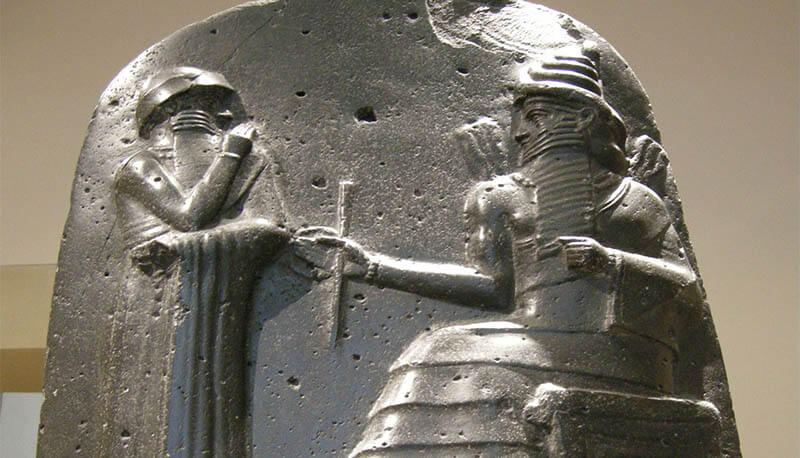Biblical Archaeology: the Code of Hammurabi

Hammurabi, the Amorite family, It was perhaps the greatest king of Mesopotamia. We have already seen that it was the destroyer of Mari, in 1760 to.C. He is considered by many as a contemporary of Abraham. Someone had even wanted to identify with King Amraphel, of Gen. 14:1, but this hypothesis was later contested.
Hammurabi ruled first on a little wide region, nearly a buffer state, pressed from all sides. Then he tore Larsa to Elamites and became lord of all the Babylonian region.
He strove for the good of his subjects, ancient canals and repaired it dug for new, in order to fertilize the north and the south of Babylon. He consolidated the fortifications, He built temples and embellished them, He presided over the administration of justice and codified, the laws of the country. Hammurabi was not limited to promulgate decrees; He realized that it was necessary to bring together the laws related to social life, to group those that present analogies and make them known to the people as much as possible.
Hammurabi is best known for the code that bears his name; This is the oldest known collection of laws. It is engraved in cuneiform on a high stele m. 2,25, discovered in Susa, and now preserved in the Louvre Museum.
It was taken as a trophy by a king Elamite around 1120 a. C. and transported in its capital.
So this day a black basalt stele, bearing aloft a relief depicting the king with adoration, receiving the laws from the sun-god Shamash.
On the stele is written on 28 columns text in cuneiform, which comprises:
-
an introduction recalling the favors granted by the king to the temples and to the Babylonian cities;
-
the texts of laws gathered and sorted, in number, of 282. These laws affect the daily life and cater to all classes of society.
To arouse the most interest was the fact that you were in the presence of a series of laws that in many ways they were very similar to the laws of Moses. (Note that between the two laws is a day unlike several centuries).
We give below some combinations.
Code of Hammurabi
or the son of a citizen, his eye will be destroyed ".
Art. 197 : "If he breaks the bone of a citizen, his bone shall be broken. ".
Art. 200: "If a citizen, knocking out a tooth to another, his tooth he will be knocked out ".
Art 250: ."If an ox led to street clashes a citizen and kills him, This court case will have no right to trial ".
Art. 231: "If the ox of the citizen is snappier and if its the magistrate said snappier, but (the citizen) He has not severed his coma, He did not tie his ox and then this bull gores a son of a citizen and kills him, (the citizen) He will have to pay half a mina d”silver ».
Civil laws of Moses
Lev. XXIV, 19, 20: "When one has done an injury to his neighbor, it will be done as he has done: breach for breach, eye for an eye, tooth for a tooth; It will be asked the same injury that he will have made another ».
Deut XLX, 21 : "Thine eye shall not pity;: life for life, eye for an eye, tooth for a tooth, hand by hand, foot by foot ".
Esodo XXI, 28, 29: «If an ox collides with a man or a woman, he will die, the ox must be stoned and its flesh not eaten; but the owner of the ox will be acquitted. But, if the ox had already been used for some time to clash, and the owner was warned, but he did not keep him locked up, and the ox killed a man or a woman, the ox will be. stoned, and his master will also be put to death ".
The similarities between these Babylonian and biblical laws, therefore, they are remarkable; but the differences are also notable.
In Babylonian laws, properties are as important as people. In both cases the offenses have the same type of punishment; in biblical laws only crimes against the person involve physical punishment, while property crimes involve punishment in money or property.
It is pointed out by some that Hammurabi's Code is essentially utilitarian, without the sense of the human person. It is also extremely harsh towards the poor and extremely harsh on anyone who shows mercy towards slaves.
His favors go, to the big ones, to those who are advantaged in this world; no concern for the children, the old ones, the weak or the foreigners.
However, it may be possible that Jewish laws inherited certain solutions to specific problems from the Babylonians.
Beyond the similarities and differences, however, it should be emphasized that the discovery of the Code of Hammurabi helped to reject the opinions of some critics, according to which laws such as those of Moses could not have been given in such a remote time as that indicated by the Pentateuch.